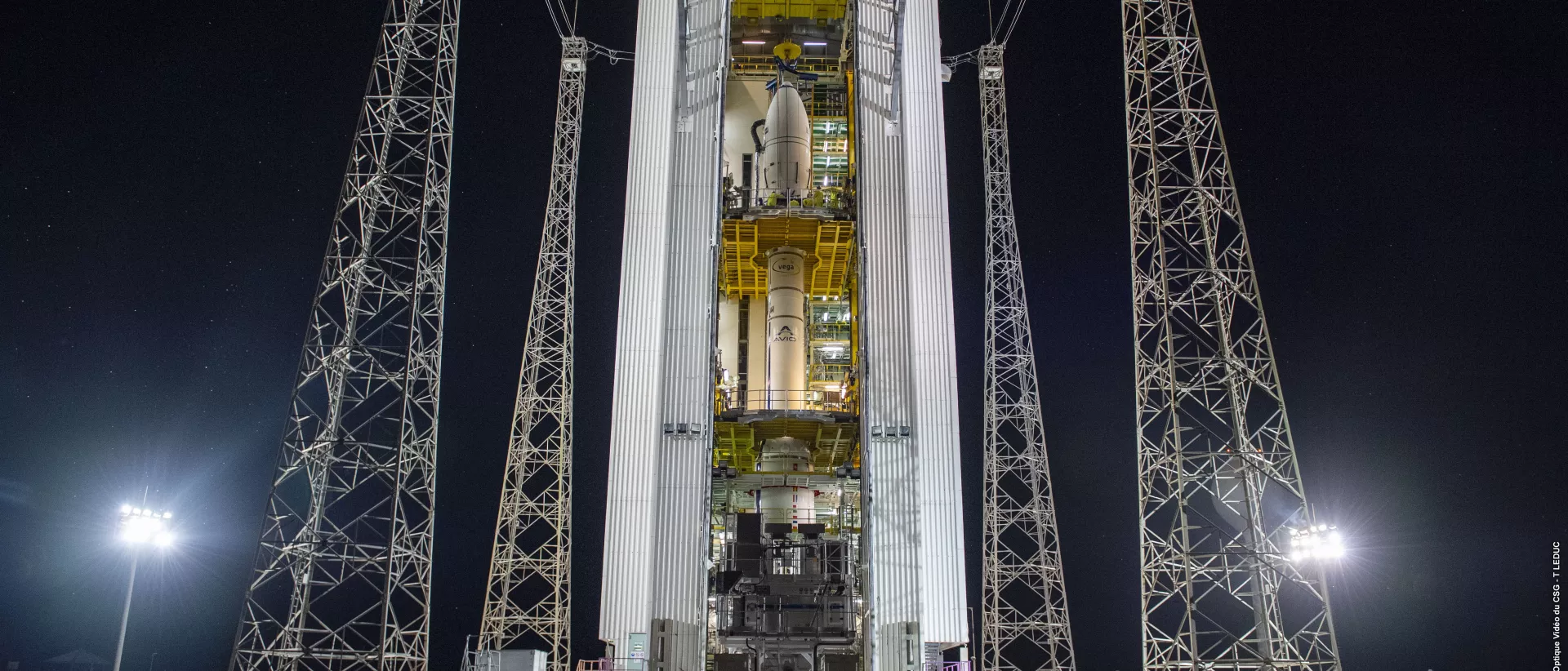
03.09.2024
Beyond Gravity: Precise In-Orbit Positioning of Europe’s New Environmental Satellite
On Wednesday, September 4, the European environmental satellite “Sentinel-2C” is scheduled to launch into space from Kourou aboard a European Vega rocket. Beyond Gravity delivered several key products for this mission. These include for example the satellite’s computer and navigation receiver.
On Wednesday, September 4 (CEST), the European environmental satellite “Sentinel-2C” will be brought into space from Europe’s spaceport in Kourou, South America, aboard a European Vega rocket. “We had the privilege to provide key elements to this environmental mission which will give science a better understanding of climate change,” says Oliver Grassmann, Executive Vice President Satellites at Beyond Gravity.
Beyond Gravity, headquartered in Zurich, Switzerland, is a leading supplier to both established customers and New Space customers. The Sentinel-2C satellite was produced by the satellite manufacturer Airbus Defence and Space at its site in Friedrichshafen, Germany.
Computer with communication and control antennas
Beyond Gravity’s site in Gothenburg, Sweden, delivered the On Board Computer of the Sentinel-2C environmental satellite. The computer controls the satellite platform and manages the spacecraft position and orbit, it ensures that the spacecraft stays healthy, and communicates with the Earth. Beyond Gravity also provided the S-Band TTC (Telemetry, Tracking and Command) antenna and the Remote Interface Unit. The TTC antenna acts as communication and control antenna for the satellite.
Precise positioning for more accurate environmental data
The centimeter-precise position of the satellite in space will be determined with the help of technology from Beyond Gravity’s site in Vienna, Austria. The more accurate the positioning, the more accurate the data the satellite will provide. Currently, 25 Beyond Gravity navigation receivers are determining the position of satellites in space for several European and international missions. Beyond Gravity’s site in Zurich, Switzerland, supplied to Airbus the solar array drive mechanisms that point the solar arrays of the environmental satellite toward the Sun.
Computer for Vega rocket
At the Beyond Gravity site in Gothenburg, Sweden, the company produced the Vega On Board Computer, part of Vega Avionics System. At its location in Emmen, Switzerland, the company produced the payload fairing of the Vega rocket.
About Vega
The flight for Sentinel-2C will be the 22th and final flight for the original European Vega rocket. Vega is ESA’s small launch vehicle and first launched in 2012. Vega is specialized in placing medium-sized satellites into low Earth polar orbits that are ideal for Earth observation missions. While this is the last flight of a Vega rocket, the Vega-C rocket, which is already in service, will continue to be used in the future. For Vega-C, Beyond Gravity provides the payload fairing, the On Board Computer and the payload adapter system, including the separation system.
About Sentinel-2C
Data collected by the Copernicus Sentinel-2 satellites are used to monitor land use and change, soil sealing, land management, agriculture, forestry, natural disasters (floods, forest fires, landslides, volcanic eruptions, and erosion), and to support humanitarian relief efforts. The Sentinel-2 satellites also provide information on the pollution of lakes and coastal waters and monitor glaciers, ice and snow. Sentinel-2C will generate optical images for Copernicus, the Earth observation component of the European Union’s space program. Sentinel-2C will orbit earth at an altitude of 786 kilometers. The satellite weighs about 1.1 tons. Once in orbit Sentinel-2C will replace its predecessor, Sentinel-2A (launched in 2015). Sentinel-2B (launched in 2017) will be replaced later by another satellite.
More information about the European Union’s Copernicus Earth observation program:
https://www.copernicus.eu/en
More information about the Vega European launcher program:
https://www.esa.int/Enabling_Support/Space_Transportation/Vega
Images
Image 1: The European environmental satellite Sentinel-2C at the cleanroom in Kourou. Copyright: ESA-CNES-ARIANESPACE/Optique vidéo du CSG–S. Martin.
Image 2: Sentinel-2C during testing. Copyright: IABG.
Image 3: Sentinel-2 in orbit. Copyright: ESA/ATG Medialab.
Image 4: The European Vega rocket with the Sentinel-2C satellite aboard in the Vega launch tower at Europe’s spaceport in Kourou. Copyright: ESA-CNES-ARIANESPACE/Optique vidéo du CSG–T. Leduc.
Video
Video of Sentinel-2 © ESA: https://www.esa.int/ESA_Multimedia/Videos/2015/04/Mapping_in_colour
Media release from Airbus on Sentinel-2C (July 2024): https://www.airbus.com/en/newsroom/press-releases/2024-07-airbus-built-copernicus-sentinel-2c-climate-satellite-heading-for
Media Release from Arianespace on the launch of Sentinel-2C and the last flight of the Vega rocket: https://newsroom.arianespace.com/arianespace-to-launch-europes-copernicus-earth-observation-program-sentinel-2c-satellite-on-september-3/
Please contact us for further information:
Philipp Bircher, VP Communications & Branding
+41 79 790 11 81, philipp.bircher@beyondgravity.com
Christian Thalmayr, Senior Manager Global Communication
+43 180199, christian.thalmayr@beyondgravity.com
